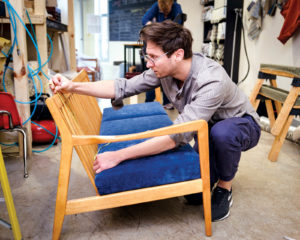
“Old Man and the Settee.” Photo: Steve Foley.
The president of the Professional Upholsterers’ Association of Minnesota proudly states that she was the fifth woman to graduate from an upholstery curriculum at Minneapolis Technical College in 1977.
“It was considered a man’s field back then,” says Diana Shroyer Guenther, owner of Shroyer Custom Upholstery in Coon Rapids, Minn. She worked one year for the program’s third woman graduate before starting her own home-based business. She subsequently worked for a furniture manufacturer, a foam and upholstery company and a restaurant booth manufacturer before her recent semi-retirement that sees her back on her own footing with residential, boat and small commercial jobs.
“When I started in the business, reupholstering cost less or the same as buying new. Now, with the economical lines of furniture, it often costs more than buying new, unless you are comparing it to upper-end, quality furniture lines,” Guenther says. “The clients we have know the value of better-built furniture or are reupholstering furniture that has sentimental value.”
Chip Lueck, owner of Recovery Room in Panama City Beach, Fla., started in the upholstery industry a year after Guenther and says his business—with a team of eight upholsterers—continues to evolve.
“I gave up automotive upholstery three years ago, because I can’t find employees to do it. I gave up $200,000 a year in gross receipts,” he says, noting that the employee he had working on automotive upholstery left for a better-paying job with a local dealership.
Due to the same difficulty in finding qualified workers, Lueck also abandoned the furniture upholstery market, though he occasionally does porch and patio furniture cushions.
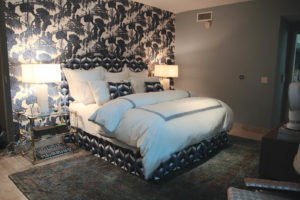
“At one time, I was full service,” he says, estimating his markets were 65 percent marine, 10 percent each automotive and furniture, and 15 percent awnings. These days, awnings account for 50 percent of his business.
“I can transition [between markets], because I am trained in all of it, but my employees are not,” says Lueck, who designates two employees for marine canvas, two for boat seats and covers, two for awning frames and one for awning covers. “I have one person who couldn’t make a cushion for a piece of furniture to save his life, but he can do some of the most complex marine canvas in the world.”
Branching out
Phillip Russell, president of PCR Restorations and Lehr Awning Co., has been in the upholstery industry 29 years—starting in a 100-square-foot basement space and now running a 16,000-square-foot operation with 13 employees.
“Before the recession, we did $1.4 million a year. From 2007 to 2014, we got down to $800,000. Now we are back up to a million a year: $300,000 in upholstery, $80,000 to $100,000 in marine (upholstery and houseboat canopies and enclosures) and the rest in awnings,” Russell says. “PCR’s niche is restaurant upholstery. We take one chair, make a pattern, and do 200 chairs.”
He has found a lucrative market in restaurant chains such as Applebee’s, Red Lobster and Olive Garden (he also does awnings for the latter). According to Russell, before the recession, Applebee’s refreshed its stores every five years.
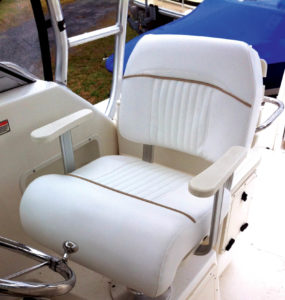
“I would go to a store, pull it out, put a new one in, take that chair back to the shop, put new fabric on, and take it to the next store,” he says, adding that he also was upholstering seats and walls for another dining chain (since closed) that was opening three venues every four months. From its base in Mansfield, Ohio, PCR—with a fleet of seven trailers, five pickups and three vans—has traveled to jobs as far north as Michigan and as far south as Florida.
“We live in a small town of 30,000, so we travel anywhere they want us to if we can make it profitable,” Russell says.
“If you have two booths ripped, I can’t drive 200 miles for $120; so I find five or six companies that need our business,” he notes, explaining that he calls ahead to accounts in an area where he has one job to see what work they might have for him. His crew may service eight or nine restaurants in a day.
PCR’s other markets include school bus seats, gyms, houseboats and residential furniture.
“We don’t do a lot of furniture, because you can buy a new La-Z-Boy recliner as cheaply as I can re-cover your old one,” Russell says. “Also, it’s too time-consuming. You can’t pay a good wage and redo a couch unless you are set up to do that.”
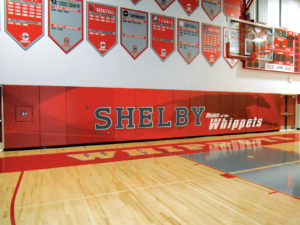
In a similar vein, the owner of Sewline Upholstery Ltd. in Medicine Hat, Alberta, Canada, draws the line at the time-consuming job of convertible car tops.
“I have one service bay for a vehicle or boat, so I have to say no to that service until I go to a larger building,” Robert Burkart says. What he will do runs the gamut from furniture, automobiles and boats to gazebos and padded covers to protect windshields of agricultural and construction equipment during transportation.
At the end of 2016, just shy of his now 27 years in the business, Burkart entered into a contractual relationship with two women in their 60s to expand Sewline’s offerings to draperies and blinds. Furniture, however, remains the company’s foremost market—a factor that Burkart attributes to people wanting more durability than the three-to-five-year life of department store furniture.
But the most profitable segment of Sewline’s markets is awnings and shade screens, which the company does not make but installs. On the other end of the scale, automotive work generates the least net income for the company.
“It takes 20 to 40 hours to do a hot rod,” Burkart says. “As soon as you peel everything apart, you see problems that were not visible.”
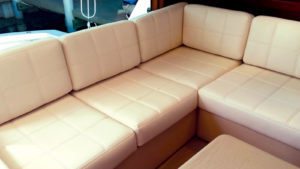
Division of labor
Leo Pohlmann founded Uncharted Marine Canvas 28 years ago; 14 years ago he expanded his services to include marine upholstery, which now accounts for half of the Gulf Breeze, Fla.-based company’s business.
“Our primary upholsterer came to us by way of Houston, Texas. He has experience in the automobile custom upholstery industry, with no background in marine upholstery,” Pohlmann says. He notes that, while the techniques for auto, home and marine upholstery have a lot in common, the latter requires recognizing that the product will be exposed to the elements.
“All of our sewers are cross-trained in sewing boat canvas and upholstery,” he says. “The most difficult transition is that interior upholstery remains clean, whereas with marine canvas, you are working with wet, dirty, moldy materials that you must tear apart before you can begin the re-covering process.”
At Sewline, employees work across all fields, but in discrete workspaces.
“I have one area for industrial and automotive. For furniture, the sewing machine has to be very clean,” Burkart says. “We may only do furniture one week. Some jobs focus on car seats, but that is greasy. We watch very carefully that everything gets covered up.”
“We try to keep upholstery work in a separate area than boat enclosure work for obvious messy reasons,” says Rick Wisotzkey, one of two canvas technicians at Short’s Marine in Millsboro, Del. “And we try to keep new boat sales work separate from used work. We also try to keep things separated by job—for example, bimini tops and enclosures from pontoon boat covers and furniture covers, keeping one employee in a fast groove of doing repetitive work and another in the slower/not-the-same-all-the-time jobs. That way, an individual doesn’t have to keep switching gears.”
At the age of 12, Wisotzkey began learning about automobile work in his father’s shop. Today, in addition to working at Short’s Marine, he maintains a shop in his house for automobiles. Per job, cars are more profitable than boats because the smaller pool of skilled labor available to perform custom car interiors brings with it the ability to charge a premium, he says. However, by volume, Short’s Marine makes more money on boat jobs.
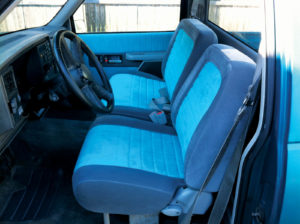
While the crossover of skills for different upholstery products is “very liquid,” Wisotzkey says, “the lack of knowledge in an area can create some less desirable outcomes.”
Sand Sea and Air Interiors Inc. of San Juan, Puerto Rico, primarily works on seating for yacht interiors and the hospitality industry, but also has upholstered wall panels for residential and commercial settings, and last year built and upholstered custom beds. Owner Terri Madden notes that marine upholstery has been her most profitable market in 2017 due to “mega yachts” coming to San Juan for refits.
“It is a specialized market for high-quality repairs or replacements with a tight turnaround,” she says. “And there is little resistance to pricing for custom requests.”
On the flip side, aviation is her least-profitable market, accounting for less than 5 percent of sales.
“Recordkeeping is a trail of paperwork, with annual inspections for compliance and evolving forms and regulations,” Madden says.
As Shroyer Customer Upholstery’s Guenther notes, “Upholstery businesses mostly market according to their skills. Some shops do it all. Some won’t do recliners or hide-a-beds because of the weight and mechanics. Some shops prefer not to work with vinyl or leather. And some markets require special equipment that would be an additional investment. Yet some businesses have employees with the knowledge and skills needed across markets. The barriers are the skills to use the more difficult materials or not wanting to invest in the equipment required.”
Lueck finds a different barrier troubling.
“The biggest problem this industry faces over the next 10 to 15 years is a lack of young people coming along,” he says. “I don’t have the qualified workers to do the
work I used to do. I can’t personally do it all. If it sounds like I am crying the blues, I am. It’s a huge issue.”
Janice Kleinschmidt is a writer and magazine editor based in San Diego, Calif.
Creative thinkers, problem solvers, self-motivators: These are the descriptors Cynthia Bleskachek uses for people she thinks are a good fit for the rapidly changing upholstery industry.
“If people want to be a professional upholsterer, they have to dig in and figure out how to do it without traditional support in place,” says the owner of The Funky Little Chair in St. Paul, Minn. “But they sure could use some help, especially to do professional work where expectations are high and turnaround needs to be relatively quick.”
Bleskachek offers 12-hour advanced classes broken into weekly sessions for people who want to do more than, say, reupholster a chair they picked up at a garage sale.
“We work on honing their skills and filling in skill gaps,” she says. “Some students have started building a client base. Some are doing work for shops, either there or as a contractor.”
Bleskachek also teaches one-day master classes at shops beyond St. Paul with Steve Cone, a retired upholstery teacher and shop owner.
“Those classes are meant for people who are doing client work but may be largely self-taught,” she says.
She arranged to have HomeDecGal Susan Woodcock as a guest instructor in June. Woodcock produces three-day Custom Workroom Conferences, such as one last October in North Carolina and this past May in Tennessee.
“I created my business model to have a place to attract professional-level teachers that might have specialties outside of mine [modern custom residential],” Bleskachek says. “It just seems that education is going to have to come out of private shops or it’s not going to come at all.”
“Oddly enough, we’ve had numerous requests to fabricate projects in velvet, which I had never used in the tropics in my 20 years in Puerto Rico,” says Terri Madden, owner of Sand Sea and Air Interiors Inc. “However, velvet is now being offered in every imaginable texture and tone, including hand-painted patterns.”
“Boat owners are upgrading their crafts and outfitting the interiors to specifications with Ultrafabrics®’ high-grade, indoor/outdoor Brisa®,” says Leo Pohlmann, owner of Florida’s Uncharted Marine Canvas. According to Ultrafabrics, the polyurethane fabric provides a soft hand, sound absorption, breathability and durability. It also is GREENGUARD certified.
“We have seen upholstery on the larger sports fisherman boats integrate home interior upholstery skills for interior couches, settees, etc.,” Pohlmann says. “The marine upholstery business should continue to grow as manufacturers develop more durable and fashionable products that can be used for interior and exterior purposes.”
Although ripped and worn seating serves the profitability of an upholstery company, PCR Restorations educates clients on how to make seating last.
“A typical restaurant’s seats are worn out in a year. Employees have broken down the foam and springs by putting their knees in it,” says PCR’s president, Phillip Russell. “Look at the right side of a booth; about 12 to 18 inches in will be ripped from bussers reaching across the table.
“If I can show you how to double the life of your booths, I just saved you a lot of money, and you remember that. I’ve had most of my customers since the late ’80s to early ’90s,” he adds. “I don’t want you for a one-shot deal. I want you for a lifetime.”
 TEXTILES.ORG
TEXTILES.ORG


